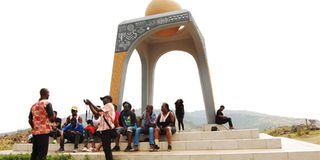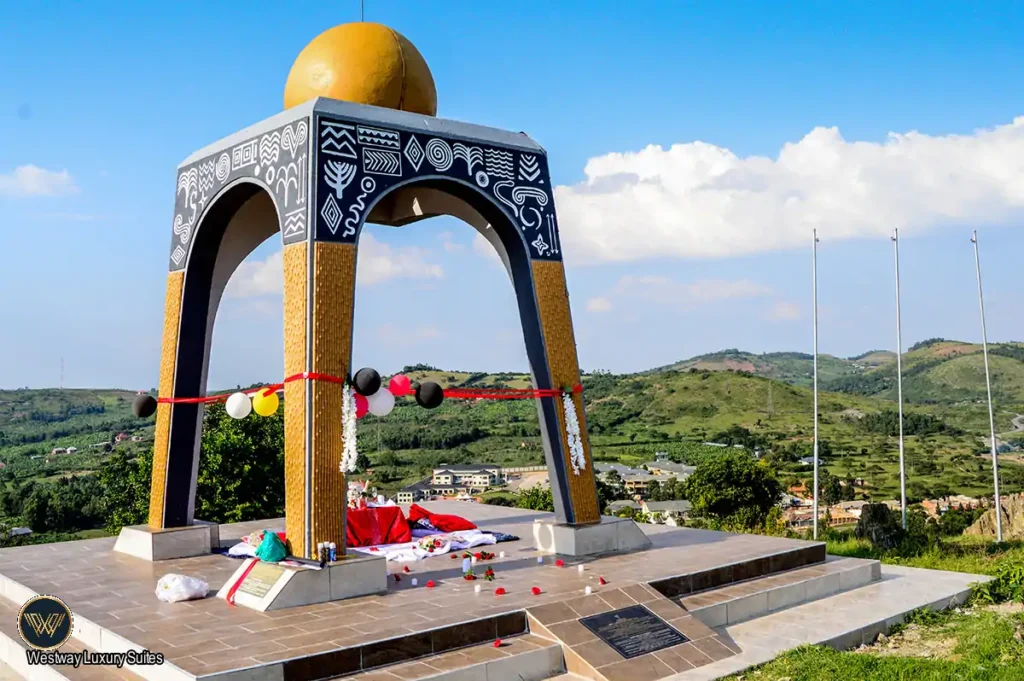What you need to know:
Lovely. It towers atop a hill in Biharwe, the eclipse monument is a wonder,
A little-known monument in Mbarara Municipality was erected in remembrance of an eclipse that is said to have happened in 1520 AD. The cosmic event had such far-reaching consequences that three kingdoms were affected in three distinct history-warping ways. The Biharwe Eclipse Monument brings that story back to life.
It stands atop of the rocky hill and can be seen from the Masaka-Mbarara highway. Although it looks miniscule from the highway more than half a kilometre away, in the valley of Biharwe, the monument is imposing up-close. The three legged structure stands at about 30 metres high with a large orange orb suspended in perfectly circular space on the top so that at around midday every day, the shadow on the ground looks like a solar eclipse.
The structure was built by Igongo Cultural Centre and inaugurated by President Museveni in 2014. The monument is not only a telescope by which we can peer deep into the dark night of history, but it is also an object of artistic beauty in the heart of the farming villages of western Uganda.
Representation
The three legs represent the three ancient kingdoms of Nkore, Bunyoro Kitara and Buganda that were affected by the 1520 eclipse so much that it remains etched in the folklore of these three peoples to date. It is this folklore that helped historians to go back in the genealogies of the kings in the great lakes region and place the eclipse at 1520 AD.
For Bunyoro Kingdom
The story goes that the king of Babiito Dynasty of Bunyoro Kitara Kingdom was Olimi I at the time of the eclipse. He was a warrior king of cosmic proportions so much so that he had come to be known as Rwitamahanga (destroyer of nations) by many Bantu groups of the great lakes region. One day, King Olimi and his fearsome warriors were returning home from their usual expeditions in Rwanda, Karagwe, Mpororo and Nkore kingdoms when the eclipse took place. The king had looted cattle in thousands and killed hundreds of people in the process. He had captured women and children whom he had turn into slaves and concubines at home.
He had reached the hilly village of Biharwe in present day Mbarara Municipality when all of a sudden the face of the sky started darkening in the middle of the day. In a few minutes, the day had turned as dark. In the king’s head, the gods of the people he had offended were conspiring to finish him. And so in repentance or fear or both, the king and his party fled making sure to leave everything behind.
Ankole Kingdom
However, the king of Nkore saw same event differently. Prior to the eclipse, his kingdom had been going through tough times after the death of almost all the cattle due to some disease. His medicine-men had tried to mitigate the problem and had failed. Poverty and starvation followed. His subjects that depended on cattle for everything were desperate.
The times had been so tough that the society, for lack of cattle, had started using wild berries for bride price. That treacherous era is still engraved in folklore as obujuganyoonza – the days when wild berries were accepted for bride price. When King Olimi I fled leaving all those cattle and everything else behind, it was seen by the king and his people as an act of benevolence from the gods. Those cows would come to be known as endugamwiguru, meaning ‘the cows that came from heaven’.
Not only did he now have the resources to buy political capital, he was now seen as a friend of the gods by his subjects. For the ancient Kingdom of Nkore, the eclipse had sparked the beginning of a period of untold prosperity for the king and his people.

Fun. A group of tourists at the eclipse monument in Igongo Biharwe. PHOTOS BY TONY MUSHOBOROZI
How it affected Buganda
Two hundred kilometres away, the people of Buganda Kingdom also saw the eclipse and not long after the dark day, they got to hear of the misfortunes of King Olimi. Word went around that the great king of Bunyoro had been deserted by his gods and that right after the sun had hidden it’s face from him. This was a sign that the king of Bunyoro was weakened for it was believed that in normal circumstances, the king of Nkore would never have defeated King Olimi I.
The king of Buganda, having been humiliated in battle by King Olimi I on many occasions, this was his cue to take revenge. He would call on his seers from Ssesse Islands for blessings and soon after that, gathered his army and off he went to attack.
The battle did not go well. The King of Buganda would get the shock of his life when he found out that the Biharwe eclipse had nothing to do with King Olimi I being deserted by his gods. The Buganda army was extirpated and the poor king killed in battle. Whether this was the beginning of the fairly well-documented great historical enmity between the two kingdoms is not clear.
Did you know
The monument was designed by a fine art student of Makerere University. It is decorated with reed masonry on the legs and engraved in heliographic lettering on the top-most part, making it a giant artefact.
Credit to: Tony Mushoborozi (Monitor)
